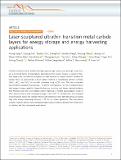Laser-sculptured ultrathin transition metal carbide layers for energy storage and energy harvesting applications
Author(s)
Zang, Xining; Jian, Cuiying; Zhu, Taishan; Fan, Zheng; Wang, Wanlin; Wei, Minsong; Li, Buxuan; Follmar Diaz, Mateo; Ashby, Paul; Lu, Zhengmao; Chu, Yao; Wang, Zizhao; Ding, Xinrui; Xie, Yingxi; Chen, Juhong; Hohman, J Nathan; Sanghadasa, Mohan; Grossman, Jeffrey C; Lin, Liwei; ... Show more Show less
DownloadPublished version (1.633Mb)
Terms of use
Metadata
Show full item recordAbstract
© 2019, The Author(s). Ultrathin transition metal carbides with high capacity, high surface area, and high conductivity are a promising family of materials for applications from energy storage to catalysis. However, large-scale, cost-effective, and precursor-free methods to prepare ultrathin carbides are lacking. Here, we demonstrate a direct pattern method to manufacture ultrathin carbides (MoCx, WCx, and CoCx) on versatile substrates using a CO2 laser. The laser-sculptured polycrystalline carbides (macroporous, ~10–20 nm wall thickness, ~10 nm crystallinity) show high energy storage capability, hierarchical porous structure, and higher thermal resilience than MXenes and other laser-ablated carbon materials. A flexible supercapacitor made of MoCx demonstrates a wide temperature range (−50 to 300 °C). Furthermore, the sculptured microstructures endow the carbide network with enhanced visible light absorption, providing high solar energy harvesting efficiency (~72 %) for steam generation. The laser-based, scalable, resilient, and low-cost manufacturing process presents an approach for construction of carbides and their subsequent applications.
Date issued
2019Department
Massachusetts Institute of Technology. Department of Materials Science and EngineeringJournal
Nature Communications
Publisher
Springer Science and Business Media LLC